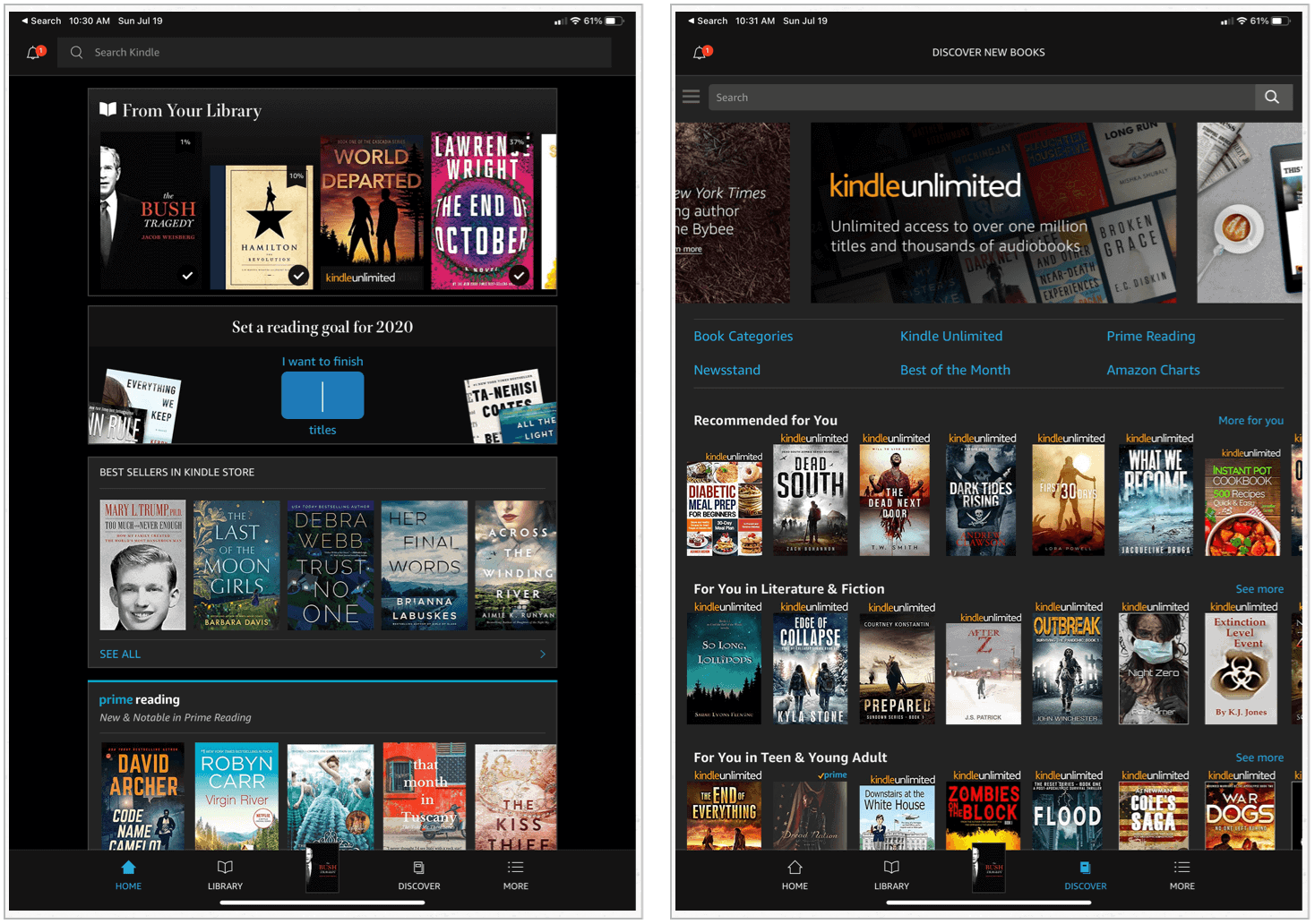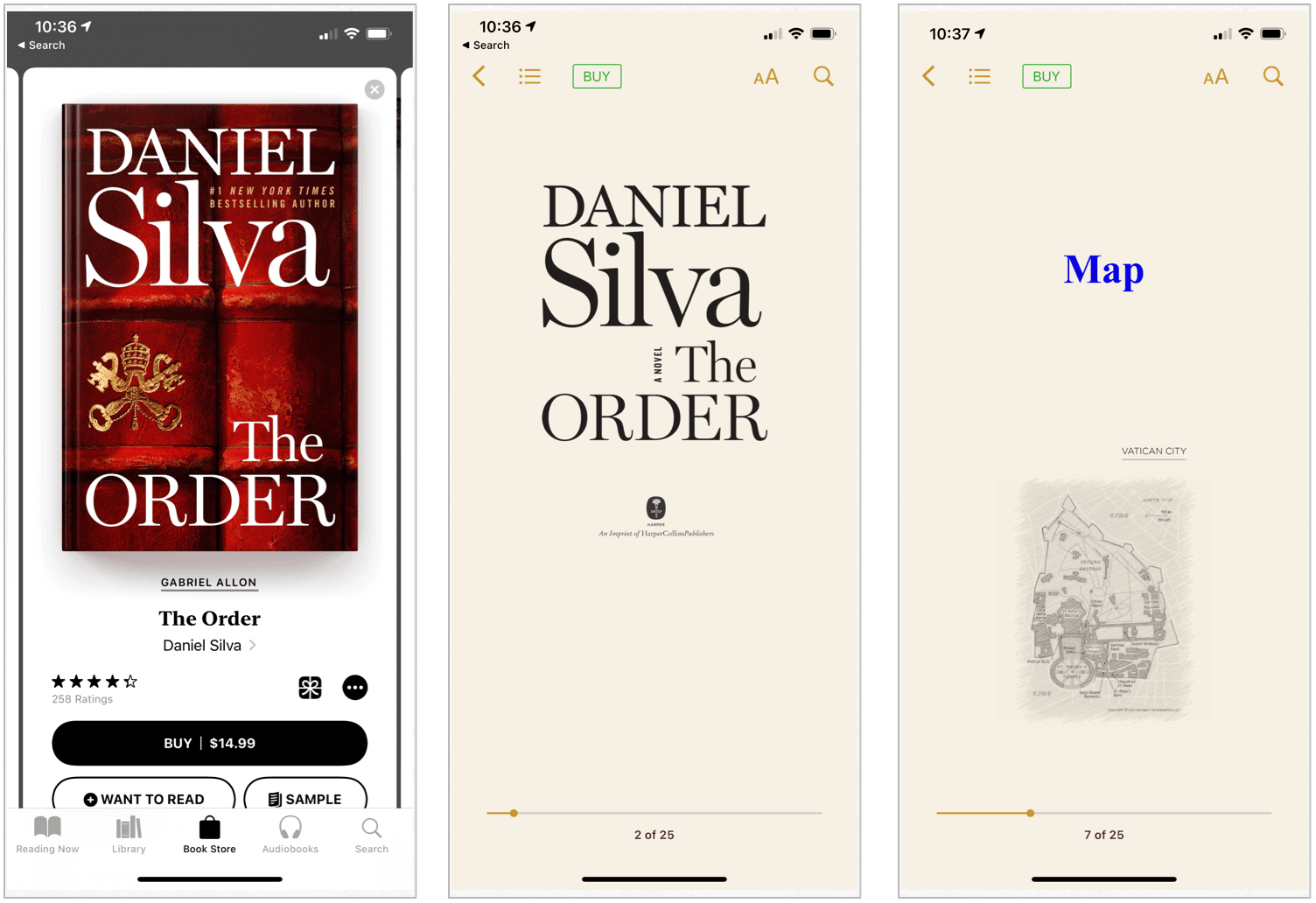Apple Books Versus Amazon Kindle Books App 2020

Should you get your eBooks from Amazon or Apple Books? We take a look at what you need to know.
Over the years, Amazon has convinced millions of readers to make the switch to e-books. Therefore, it makes sense that the company’s Kindle platform remains the most popular in the world. For anyone new to e-books or are looking to make a switch, distant No. 2 Apple Books is worth considering, especially after a significant 2018 update that added more features and refinements. Here’s a look at the advantages and differences between the Amazon Kindle and Apple Books ecosystems, and why one might be better than the other depending on your situation.
Amazon Kindle
Once solely a lineup of e-readers, Amazon Kindle is now both a hardware and software platform that includes e-books, newspapers, magazines, and other digital media.
On the hardware side, you’ll currently find three primary devices, including the entry-level Kindle, mid-priced Kindle Paperwhite, and the flagship, Kindle Oasis. Each Kindle e-reader uses e-ink, which gives off the appearance of ordinary ink on paper. For those without a physical Kindle, Amazon offers free Kindle reading apps across various platforms such as Mac/PC, iOS/iPadOS, Android, and many more.
Amazon Kindle content syncs across any device that uses an Amazon account login. You can share Kindle e-books with family members, and through the Kindle books lending program, loan select books to family and friends for 14 days at a time.


Pros
No doubt, iPads are impressive devices that serve various purposes. However, if you’re looking for anything close to an actual reading experience on a digital device, you can’t do better than an Amazon Kindle.
Thanks to E-Ink, the display on Kindle device reads like paper without glares in bright sunlight. Also, the text is designed to read like a printed page with the pixel level set for maximum readability.
Additionally, Kindle devices offer great battery life with the time between charges measured in weeks, not days.
Whether you’re using Kindle hardware or only software, Amazon offers built-in translation and Wikipedia integration. The company’s unique X-Ray tool is also present. With X-Ray, you can learn more details about the characters, locations, themes, and ideas in many e-books.
Kindle also comes with Goodreads, a social cataloging website that allows you to search for annotations, quotes, and reviews of the current book. Goodreads also offers surveys, polls, blogs, and discussions.
Amazon Kindle users can also subscribe to Kindle Unlimited. Launched in 2014, the $9.99-per-month Kindle Unlimited service gives you access to over 1 million e-books and thousands of audiobooks. It also includes a growing selection of current magazines.
Self-published content has a significant imprint in Kindle Unlimited. However, there’s also fare from publishers such as Houghton Mifflin Harcourt, Lonely Planet, Pottermore, Simon & Schuster, Timber Press, and more.
Finally, Amazon Prime customers will find over a thousand books, magazines, comics, Kindle Singles, and more through Amazon Kindle at no additional charge. Prime Reading comes with Audible Narration, allowing you to seamless switch between reading and listening.


Cons
The biggest beef many Apple device owners have with the Amazon Kindle app is the inability to purchase books in-app. Instead, users must buy from the Amazon website first. The negative here is because Amazon decided a long time ago not to accept Apple’s App Store rules, which require publishers to give the iPhone maker up to 30% of all sales. You can, however, download samples of books directly from the app.
Apple Books
First launched in 2010 as iBooks, Apple Books is an all-in-one e-book reading and store app that’s available on macOS, iOS, and iPadOS. To date, Apple Books aren’t available on non-Apple devices.
Like many of the company’s other products, Apple Books are synced across all platforms using iCloud. Apple Books are shareable with anyone that’s a member of an Apple Family.


Pros
Apple Books is a full integrated e-book system that combines both the reading experience and online store. Because of this, the process is much more integrated than Amazon Kindle. The integration extends to audiobooks, which are also available in-app. When you purchase a book and its audiobook counterpart, you can switch back and forth with ease.
With iOS 12 in 2018, several changes were made to the iBooks app, starting with the changing of its name to Apple Books. The latest version offers a much more integrated store that includes e-books and audiobooks. The update also added the ability to create library collections for better organization.
Also, Apple tweaked the customizing experience to make it much more user-friendly. These include the ability to change the size and type of font and the color of the digital e-book paper. Apple Books also lets you store PDFs, which you can seamlessly sync through iCloud for viewing across all of your devices.


Cons
The most significant Apple Books negative shouldn’t come as much of a surprise. It’s that the content is only available on Apple devices. Therefore, for example, if you ever switch to Android or Windows, your purchased e-books will become lost, which isn’t the case with Amazon Kindle titles.
Prices and Content
As you saw above, there are not that many “cons” with either Amazon Kindle or Apple Books. That’s because when you boil it down, content is mostly the same across both ecosystems. Sure, you’ll find exclusive content on one or the other. However, this is less likely with broadly released content from any of the large publishing houses. You’ll also quickly notice that the price either charges for a book is nearly identical. The reason is those same publishing companies mostly control the book pricing, especially for newer titles.
Conclusion: Choose Both
If you’re in the market for an e-book reader, Amazon’s Kindle lineup is more-or-less the only game in town. However, if you’re planning on reading e-books from apps on mobile devices, your choices open up considerably. Under this scenario, perhaps the best solution is to use both platforms.
Because only Amazon offers the Kindle Unlimited subscription plan, your best bet might be to consider putting both apps on your Apple device, and going back and forth between the two. For example, you can buy e-books through Apple Books to take advantage of family sharing by also use the Amazon Kindle app to take advantage of Kindle Unlimited and Amazon Prime.
Another reason to use both apps is to take advantage of price differences when they do occur. Sure, this doesn’t happen often, but when it does, you’ll be ready to save some cash. To find the best prices, I suggest checking out BookBub. The free site allows you to quickly find the best price on the titles you want, regardless of the platform.
There’s no “right” or “wrong” voice when it comes to e-book reader apps. Both Amazon Kindle and Apple Books. Whichever you choose, happy reading!






